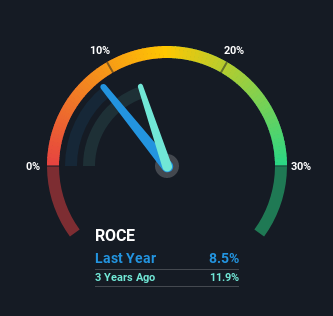- Chile
- /
- Water Utilities
- /
- SNSE:IAM
The Returns On Capital At Inversiones Aguas Metropolitanas (SNSE:IAM) Don't Inspire Confidence
There are a few key trends to look for if we want to identify the next multi-bagger. Ideally, a business will show two trends; firstly a growing return on capital employed (ROCE) and secondly, an increasing amount of capital employed. Ultimately, this demonstrates that it's a business that is reinvesting profits at increasing rates of return. In light of that, when we looked at Inversiones Aguas Metropolitanas (SNSE:IAM) and its ROCE trend, we weren't exactly thrilled.
What is Return On Capital Employed (ROCE)?
Just to clarify if you're unsure, ROCE is a metric for evaluating how much pre-tax income (in percentage terms) a company earns on the capital invested in its business. The formula for this calculation on Inversiones Aguas Metropolitanas is:
Return on Capital Employed = Earnings Before Interest and Tax (EBIT) ÷ (Total Assets - Current Liabilities)
0.085 = CL$192b ÷ (CL$2.5t - CL$249b) (Based on the trailing twelve months to December 2021).
Therefore, Inversiones Aguas Metropolitanas has an ROCE of 8.5%. On its own, that's a low figure but it's around the 9.6% average generated by the Water Utilities industry.
See our latest analysis for Inversiones Aguas Metropolitanas

Above you can see how the current ROCE for Inversiones Aguas Metropolitanas compares to its prior returns on capital, but there's only so much you can tell from the past. If you'd like to see what analysts are forecasting going forward, you should check out our free report for Inversiones Aguas Metropolitanas.
What The Trend Of ROCE Can Tell Us
When we looked at the ROCE trend at Inversiones Aguas Metropolitanas, we didn't gain much confidence. Over the last five years, returns on capital have decreased to 8.5% from 12% five years ago. Meanwhile, the business is utilizing more capital but this hasn't moved the needle much in terms of sales in the past 12 months, so this could reflect longer term investments. It may take some time before the company starts to see any change in earnings from these investments.
In Conclusion...
In summary, Inversiones Aguas Metropolitanas is reinvesting funds back into the business for growth but unfortunately it looks like sales haven't increased much just yet. And investors appear hesitant that the trends will pick up because the stock has fallen 42% in the last five years. On the whole, we aren't too inspired by the underlying trends and we think there may be better chances of finding a multi-bagger elsewhere.
Inversiones Aguas Metropolitanas does come with some risks though, we found 3 warning signs in our investment analysis, and 2 of those are a bit concerning...
While Inversiones Aguas Metropolitanas isn't earning the highest return, check out this free list of companies that are earning high returns on equity with solid balance sheets.
New: AI Stock Screener & Alerts
Our new AI Stock Screener scans the market every day to uncover opportunities.
• Dividend Powerhouses (3%+ Yield)
• Undervalued Small Caps with Insider Buying
• High growth Tech and AI Companies
Or build your own from over 50 metrics.
Have feedback on this article? Concerned about the content? Get in touch with us directly. Alternatively, email editorial-team (at) simplywallst.com.
This article by Simply Wall St is general in nature. We provide commentary based on historical data and analyst forecasts only using an unbiased methodology and our articles are not intended to be financial advice. It does not constitute a recommendation to buy or sell any stock, and does not take account of your objectives, or your financial situation. We aim to bring you long-term focused analysis driven by fundamental data. Note that our analysis may not factor in the latest price-sensitive company announcements or qualitative material. Simply Wall St has no position in any stocks mentioned.
About SNSE:IAM
Inversiones Aguas Metropolitanas
Through its subsidiaries, engages in the sanitation business in Chile.
Good value with moderate growth potential.
Market Insights
Weekly Picks

Solutions by stc: 34% Upside in Saudi's Digital Transformation Leader


The AI Infrastructure Giant Grows Into Its Valuation
Recently Updated Narratives

Perdana Petroleum Berhad is a Zombie Business with a 27.34% Profit Margin and inflation adjusted revenue Business
Many trends acting at the same time


Engineered for Stability. Positioned for Growth.
Popular Narratives


MicroVision will explode future revenue by 380.37% with a vision towards success


NVDA: Expanding AI Demand Will Drive Major Data Center Investments Through 2026



